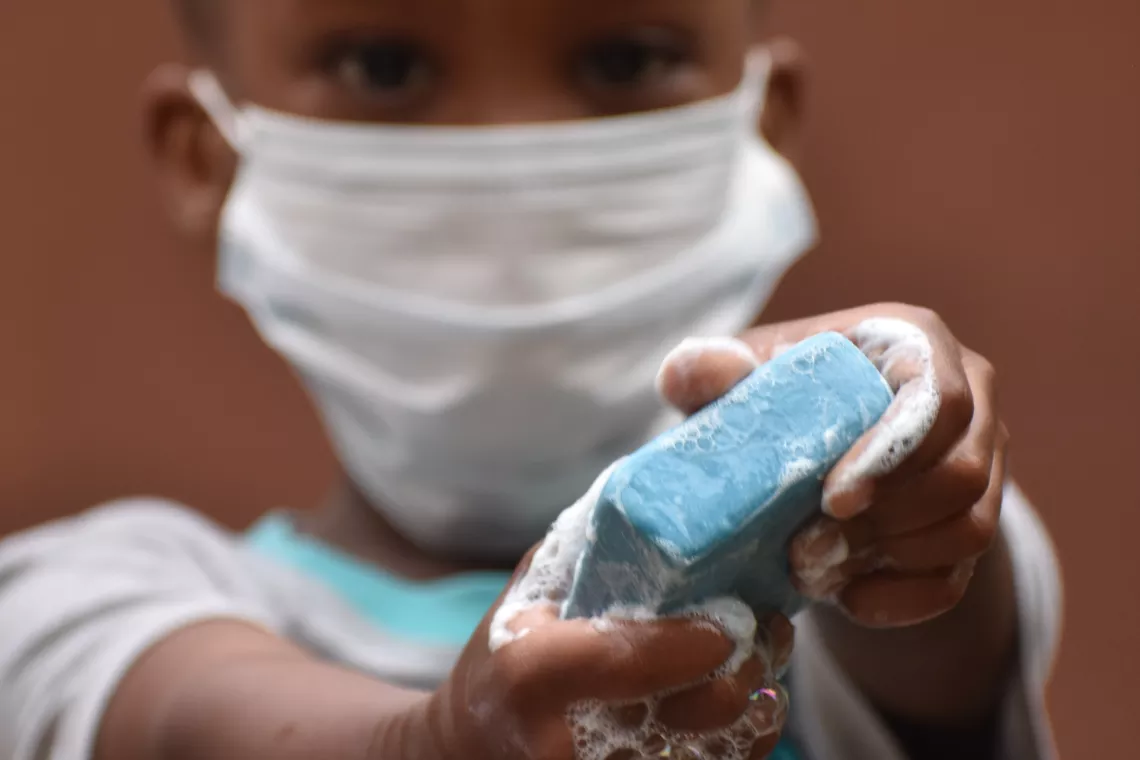Reopening schools safely in the Philippines
Without urgent action, the learning crisis could turn into a learning catastrophe

Schools in the Philippines have been closed since the start of the COVID-19 pandemic. The Philippines also had one of the longest school breaks in the world, without any type of formal classes from March 2020 to October 2020. Although basic education enrolment for 2021-2022 is at 100.3% compared to the previous schoolyear (as of 15 September 2021), an estimated 27 million students in the Philippines have lost more than a year of in-person learning.

On 20 September 2021, the Philippine Government approved a pilot run of limited in-person schooling in low-risk areas.
As some schools are set to reopen on a small scale, public health and safety measures are also important to keep every child and every teacher safe.
UNICEF is working closely with the Department of Education and Department of Health to support the planning and preparation for safe in-person learning, beginning with the pilot schools.
What are the negative effects of prolonged school closures on children?
- The lack of in-person interaction with peers tremendously impacts children’s emotional and cognitive development. The missed opportunity for immediate teacher-learner interaction on the lessons delays competency development of the learner and has serious impact on quality learning.
- Children’s ability to read, write and do basic mathematics suffer, and the skills they need to thrive in the 21st century economy have been diminished.
- The longer children are out of school, the less likely they are to return. Out-of-school children are more vulnerable to early marriage, teenage pregnancy and child labour.
- Their physical and mental health, development, safety and well-being are at risk.
- More screen time and time spent online has increased the risks of online violence and abuse.
- Without the safety net that school often provides, they are more vulnerable to abuse, gender-based violence including sexual exploitation and child marriage, and child labour that they may experience at home, especially in the stressful context of the pandemic.
- Children miss out on the mental health, psychosocial support, and health and nutrition services offered by schools.

Distance learning is not a replacement for in-person classes
Children are learning less under distance learning modalities. According to a UNICEF-SWS survey in May 2021, most parents (84%) observed that, despite spending more time guiding them, their children were learning less in distance learning than in traditional in-person learning.
Parents need to be highly involved in distance learning. Parents who may not have enough background, time or resources to assist in distance learning face difficulties providing the needed support to their children.
Is it safe for children to go back to school?
Global data shows that schools are not main drivers of COVID-19 transmission (UNICEF and UNESCO, 2020). Globally, children account for a very small proportion of confirmed COVID-19 cases. They have milder symptoms compared to adults, and they have not contributed significantly to the proportion of hospitalized cases or reported deaths (WHO-UNICEF, 2021).
Children of primary school age and younger appear to be less likely infected and less likely to pass on the infection to others (WHO-UNICEF, 2021).
In the Philippines, children and adolescents comprise a very small proportion (9%) of total reported cases (PIDSP, 2021). Children and schools are unlikely to be the main drivers of COVID-19 transmission, when community transmission is low.
Children have the right to education.
The vaccination of teachers and students should not be a prerequisite for schools to reopen.

How can schools reopen safely?
UNICEF is supporting the Department of Education and Department of Health in planning for the phased, voluntary and safe reopening of schools in pilot low-risk areas in the Philippines. Low-risk areas are municipalities with less than 1 COVID-19 case per 100,000 population and negative growth rate in the last 2 weeks.
To ensure the safety of children who will be attending in-person classes, all possible steps to mitigate virus transmission in school must be taken including:
- Mask, face shield and other PPE policies for teachers, school staff and students in accordance with national and local guidelines
- Enhanced hygiene measures and adequate handwashing facilities
- Frequent cleaning of surfaces and shared objects
- Adequate and appropriate ventilation
- Cohorting and alternating physical presence to maintain physical distancing and small groups
- Information-sharing mechanisms with parents, students and teachers
- Setting criteria and mandatory procedures for temporary school closure in the event of a COVID-19 outbreak in the area
Framework for School Reopening
While not a prerequisite to reopen schools, teachers should be prioritised for COVID-19 vaccination, after frontline health workers and those most at risk, to help protect them from community transmission.

Continued support to enhance distance learning
Distance learning modalities should not leave any child behind. For those who are unable to attend in-person classes, distance learning modalities have to be strengthened to ensure that children are learning effectively. Online learning delivery platforms have to be improved. Investments must be made to close the digital divide. Teachers must be trained to effectively design and conduct lessons remotely.
Reimagining a better future for children
Without urgent action and increased investment, the COVID-19 and pre-existing learning crisis could turn into a learning catastrophe.
If schools continue to be closed, more children and young people, especially the most vulnerable and disadvantaged, will stop schooling altogether. Without access to quality remote learning, children from the most marginalized communities pay the heaviest price, affecting their future and fueling inequality.
Resources for parents
- 5 ways to help keep children learning during the COVID-19 pandemic
- What will a return to school during COVID-19 look like?
- How to support your child through reopening: tips for guiding your child through transitions from family life under COVID-19 restrictions
- How to keep your child safe online while stuck at home during the COVID-19 outbreak
- Supporting your child’s mental health during COVID-19 school returns



